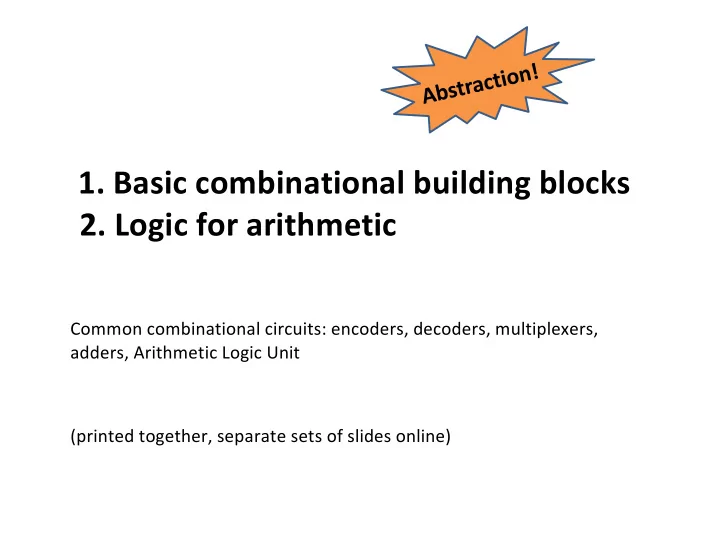

1. Basic combinational building blocks 2. Logic for arithmetic Common combinational circuits: encoders, decoders, multiplexers, adders, Arithmetic Logic Unit (printed together, separate sets of slides online)
But first… Recall: sum of products logical sum (OR) of products (AND) of inputs or their complements (NOT). Construct with: A B C M • 1 code detector per 1-valued output row 0 0 0 0 • 1 large OR of all code detector outputs 0 0 1 0 0 1 0 0 Is it minimal? 0 1 1 1 1 0 0 0 1 0 1 1 1 1 0 1 1 1 1 1
Gray Codes = reflected binary codes Alternate binary encoding designed for electromechanical switches and counting. 00 01 11 10 0 1 2 3 000 001 011 010 110 111 101 100 0 1 2 3 4 5 6 7 How many bits change when incrementing?
ex Karnaugh Maps: find (minimal) sums of products CD gray code order 00 01 11 10 A B C D F(A, B, C, D) 0 0 0 0 0 00 0 0 0 0 0 0 0 1 0 0 0 1 0 0 01 0 0 0 1 0 0 1 1 0 AB 0 1 0 0 0 11 1 1 0 1 0 1 0 1 0 0 1 1 0 1 10 1 1 1 1 0 1 1 1 0 1 0 0 0 1 1. Cover exactly the 1s by drawing a (minimum) number of 1 0 0 1 1 maximally sized rectangles whose dimensions (in cells) 1 0 1 0 1 are powers of 2. (They may overlap or wrap around!) 1 0 1 1 1 2. For each rectangle, make a product of the inputs (or 1 1 0 0 1 complements) that are 1 for all cells in the rectangle. 1 1 0 1 1 ( minterms ) 1 1 1 0 1 3. Take the sum of these products. 1 1 1 1 0
ex Voting again with Karnaugh Maps A B C M 0 0 0 0 0 0 1 0 0 1 0 0 0 1 1 1 1 0 0 0 1 0 1 1 1 1 0 1 1 1 1 1
Goal for next 2 weeks: Simple Processor Instruction ALU Registers Memory Fetch and Decode
Toolbox: Building Blocks Processor datapath Microarchitecture Instruction Decoder Memory Arithmetic Logic Unit Adders Registers Multiplexers Demultiplexers Flip-Flops Digital Logic Encoders Latches Decoders Gates Devices (transistors, etc.)
ex Decoders Decodes input number, asserts corresponding output. n -bit input (an unsigned number) 2 n outputs Built with code detectors. D 0 D 0 B 0 D 1 B 0 D 1 D 2 B 1 D 2 B 1 D 3 D 3
Multiplexers Select one of several inputs as output. D 0 D 1 D 2 8-to-1 D 3 2 n data inputs F 1 data output MUX D 4 D 5 D 6 D 7 A B C n selector lines
ex Build a 2-to-1 MUX from gates If S=0, then F=D 0 . D 0 2-to-1 If S=1, then F=D 1 . F MUX D 1 1. Construct the truth table. S 2. Build the circuit.
8-to-1 MUX Costume idea: MUX OX
MUX + voltage source = truth table A B C M 0 0 0 0 0 0 0 1 0 1 0 1 0 0 2 8-to-1 3 0 1 1 1 M MUX 1 0 0 0 4 1 0 1 1 5 1 1 0 1 6 1 1 1 1 7 A B C
Buses and Logic Arrays A bus is a collection of data lines treated as a single logical signal. = fixed-width value Array of logic elements applies same operation to each bit in a bus. = bitwise operator
Recommend
More recommend